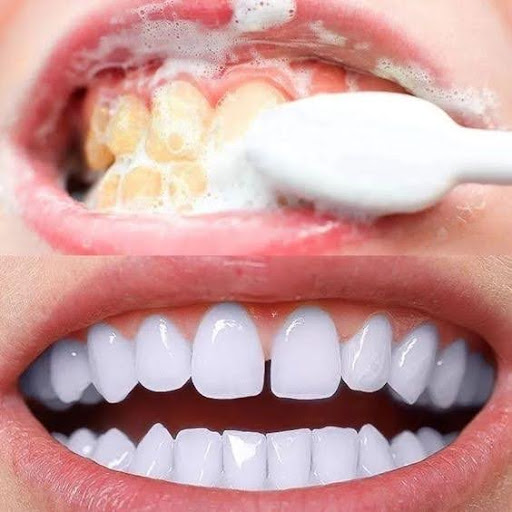If you want a smile that’s straight out of a Hollywood scene, dental bonding is a cosmetic treatment that can turn it into a reality. Bonding front teeth or any other teeth can change the shape, size, and color of your teeth to your exact preference.
Now, there’s one thing that can go slightly awry over time. Dental bonding can turn yellow, brown, or some other unpleasant shades with time. So what do you do then? Can you whiten teeth after composite bonding? Can it be done at home? Can bonded teeth be whitened? In this blog, we answer all those questions for you!
Why does bonding turn yellow?
Before we explain anything else, let’s talk about why the discoloration even happens in the first place. And what can you avoid to prevent it from happening?
There are 5 main reasons why your composite bonding has turned yellow or brown:
- Staining: Bonding material, like natural tooth enamel, can become stained over time from exposure to pigmented foods and beverages. Smoking tobacco can also cause yellowing of bonding material.
- Wear and Tear: Bonding material is not as durable as natural tooth enamel and can wear down or chip over time, exposing the underlying layers to staining agents. As the bonding material wears, it may appear yellowish or discolored.
- Poor Maintenance: Inadequate oral hygiene practices, such as infrequent brushing and flossing, can accumulate plaque and tartar on the surface of the bonding material. This buildup can cause the bonding to appear yellow or discolored.
- Age: As bonding material ages, it may naturally degrade or deteriorate, leading to changes in color and appearance. Over time, the bonding material may become more susceptible to staining and discoloration.
- Exposure to Certain Substances: Some substances, such as certain medications or chemicals, may interact with the bonding material and cause it to change color or become yellow over time.
Can bonded teeth be whitened?
Yes, bonding teeth whitening is possible! Dental bonding involves applying a tooth-colored composite resin to the surface of a tooth to improve its appearance, such as covering up stains, chips, or gaps.
While the composite resin used in bonding can be color-matched to your natural teeth, it is not as resistant to staining as your natural tooth enamel. So over time, the bonding material may become discolored or stained, especially if exposed to certain foods, drinks, or smoking.
But wait, there’s good news too!
Just like there are tons of options to fix missing teeth or to fix the stains after braces, there are ways to begin teeth whitening with bonding. It’s time to discuss those details…

How can you start whitening bonded teeth?
Whitening bonded teeth can be done in a handful of unique ways. For instance, if your bonded teeth are made from a resin-based composite, you can try out some popular at-home whitening treatments including:
- Whitening gels for bonded teeth,
- A whitening toothpaste, or
- Whitening strips
Furthermore, you can also combine these options to create a stronger regime. For instance, you can use whitening strips or gels twice a day for 20–30 minutes while brushing your teeth twice with a whitening toothpaste! This can help you achieve your goal at a faster pace than otherwise.
Now, at-home teeth whitening for bonded teeth doesn’t work in some cases. Those patients whose crowns or veneers are made out of porcelain or ceramic should not try out at-home whitening kits at all.
What you should do is visit your dentist for a professional bleaching treatment that won’t erode your tooth. These treatments can lighten the color of your veneer material and help it match better to the rest of your teeth!
Tips to take care of your whitened bonded teeth
Teeth whitening for bonded teeth can seem a little daunting if you don’t know what you’re doing. That said, it’s not as hard as it sounds. Before we come to the end of this blog, our experts have prepared a few helpful tips for whitening bonded teeth!
1. Steer clear of staining foods and drinks
Avoid or minimize consumption of certain foods and drinks known to stain teeth, such as coffee, tea, red wine, berries, and tomato-based sauces. If you do consume these items, rinse your mouth with water afterward to help reduce staining.

2. Quit smoking
Smoking not only stains teeth but also contributes to various oral health issues such as gum disease and oral cancer. Quitting this dirty habit can help preserve the brightness of your bonded teeth and improve overall oral health.
3. Use a dentist-recommended mouthwash
Choose a mouthwash recommended by your dentist, preferably one that is alcohol-free and formulated to help maintain the brightness of teeth. Mouthwash can help freshen breath and remove plaque, reducing the risk of staining and maintaining the appearance of bonded teeth.
4. Practice good oral hygiene
Brush your teeth at least twice a day with fluoride toothpaste to remove dental plaque and prevent staining. Floss daily to clean between teeth and along the gum line, where plaque and stains can accumulate. You should also consider using a whitening toothpaste formulated for bonded teeth to help maintain their brightness.
5. Have regular dental checkups
Schedule regular dental checkups and cleanings to monitor the health of your bonded teeth and address any issues promptly. Your dentist can provide professional teeth cleaning to remove surface stains and assess the condition of your bonded teeth.
Regular checkups also allow your dentist to identify any potential problems early and recommend appropriate treatment.
FAQs
Can you whiten crowns?
According to the American Dental Association, dental whitening treatments make no impact on the porcelain/composite porcelain material that makes up dental crowns. Hence, it’s impossible to bleach your crown. What the dentist can do is whiten your existing teeth to match the color of the crown.
Will baking soda whiten bonded teeth?
Baking soda is the king of all cleaning hacks. But despite its popularity as a whitening agent, it does not work well for whitening bonded teeth. Initially, you might notice it removes the surface-level stains on natural teeth, but it can erode the softer composite material with its abrasive texture.
Why is my tooth bonding turning brown?
Let’s get this straight: teeth bonding can change color over a period of time. But it doesn’t occur naturally and always has to do with your lifestyle choices. For example, drinking a lot of coffee can turn it yellow and the same goes for chronic smoking habits. It can also become gray or black in color if it isn’t properly placed on the tooth or if there is severe damage or decay within the teeth.
Do teeth rot under bonding?
In short, no. Teeth bonding doesn’t rot your teeth and bears no harm to your oral health. However, if you have severe tooth decay, gum disease, or any other dental issues, you’ll need to pursue other treatments before you can get to dental bonding.
Final Thoughts
Composite bonding can give you a picture-perfect smile in no time. Yet, things can go south if and when these bonded teeth turn a different color than a dazzling white! Gladly, there are many ways you can whiten your bonded teeth back to the perfect shade in no time.
For those of you who are in a pickle about whitening bonded teeth, visit Premier Dental at any of our branches and get the best advice from board-certified experts. With gentle care and field expertise, we can lead you back to oral health and aesthetics the right way!


